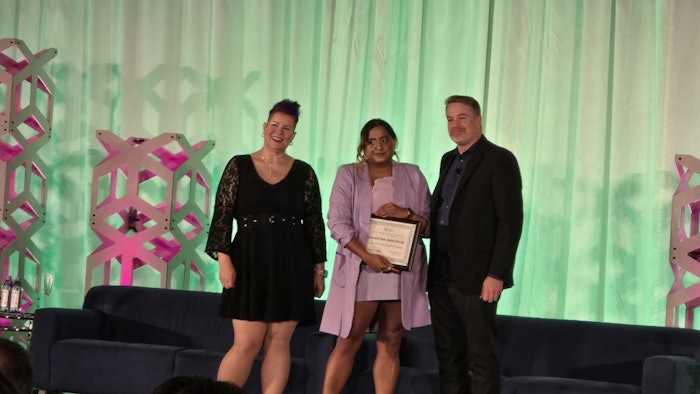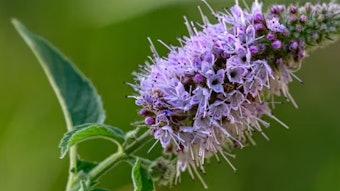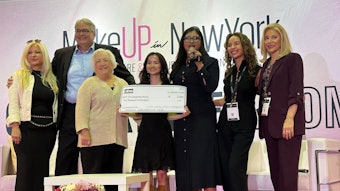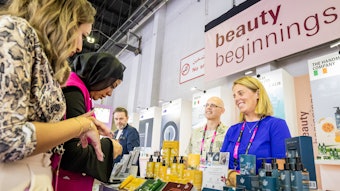
Day three of the Society of Cosmetic Chemists' 78th (SCC78) Annual Scientific Meeting and Technology Showcase opened with the SCC Annual Awards Breakfast featuring the Henry Maso Keynote Lecture, which set the tone for one of the event's major themes: inclusive beauty. The presentation was a fireside chat-style discussion with Avantha Arachchi, chief operating officer of A-Frame Brands, a brand-building portfolio designed to address the needs of underrepresented groups.
Several awards presentations preceded the keynote, followed by breakout sessions throughout the day on: inclusive beauty, advancing photoprotection, skin care technologies, and biodiversity and sustainable ingredient design. In addition, times were set aside to visit the exhibition, and the "Serving Up Science" luncheon featured a performance by members of the Science is a Drag troupe — complete with a thoughtful discussion on the unique cosmetic needs of drag performers and a playful list of product "demands" for formulators. Following are highlights.
Celebrating Excellence: Henry Maso and Student Poster Awards, Madame CJ Walker Scholarships, SCC Award and More
 The morning kicked off with a celebration of excellence, including the following scholarships and recognitions; here, Karissa Richards, University of Toledo, was awarded the Madam CJ Walker scholarship.
The morning kicked off with a celebration of excellence, including the following scholarships and recognitions; here, Karissa Richards, University of Toledo, was awarded the Madam CJ Walker scholarship.
The morning kicked off with a celebration of excellence, including the following scholarships and recognitions.
- Student poster awards were presented to:
- Casey Posner, University of Miami (4th place),
- Patcharawan Nimmansophon, the University of Cincinnati (3rd place),
- Shamola Jaiyeoba, the University of Cincinnati (2nd place) and
- Nora Del Bosque, Texas Christian University (1st place). Her first-place poster was entitled: "Testing the Efficiency of Catalase Ligand Mimics."
- The Madam CJ Walker scholarships, sponsored by Mary Kay, honored:
- Finalists: Lauren Forney, Spelman College (undergraduate student in health science); and Holly Honoré, University of Cincinnati (graduate student in cosmetic science master of science program); and
- Winners (each receiving a $5,000 scholarship): Karissa Richards, University of Toledo (undergraduate student in cosmetic science and formulation design); and Taylor Scott, University of Cincinnati (graduate student in cosmetic science master of science program).
- The Alan B. and Jeanette Black Award, sponsored by Presperse, went to Cara Eaton, of Croda Beauty, for her work, "Carbon in the Supply Chain: A Case Study on Methodology Development for Measurement of Impact."
- The Shaw Mudge Award, sponsored by the SCC, went to Nadine Pernodet, Ph.D., of The Estee Lauder Cos., for her work, "The Future of Skin Care: Harnessing Epigenetics, from Anti-aging to Age Reversal."
- The Des Goddard Award, sponsored by the SCC, was presented for the first time to a student recipient: Casey Posner, University of Miami, for her work, "Transfer-resistant Lipsticks: Are Bio-based Film Formers Effective Substitutes for Synthetic Film Formers?"
- The SCC Award, sponsored by Hallstar, was presented to Jennifer Marsh, Ph.D., of P&G, for her work, "Delivering Hair Care Benefits from Botanicals."
- Finally, the Henry Maso Award was presented to Avantha Arachchi following her keynote discussion.
Henry Maso Keynote Lecture: Focus on DEI
As noted, the Henry Maso Keynote Lecture, moderated by COSA chair and vice chair Caryn Weiss, of Amway, and Paul Lawrence, Ph.D., of BioCogent, respectively, consisted of a conversation with Avantha Arachchi, of A Frame Brands. The brand-building portfolio is focused on the needs of underrepresented groups overlooked in retail and CPG industries. Through a partnership with mission-aligned BIPOC celebrity talent, including John Legend, Naomi Osaka, Gabrielle Union and Dwyane Wade, A-Frame has launched brands to address challenges ranging from higher incidences of melanoma in people of color, to baby care formulated specifically for children of color, as they are more prone to skin concerns.
Per Medium, prior to A-Frame, Arachchi ran her own consulting practice to help establish founders and support innovation at larger companies; and led and grew operations at Gerber Technology, Avametric, TATCHA and Tufts University Research. "As a trans woman of color, she is passionate about innovating the way organizations think, build, create and grow — placing diversity, equity and inclusion (DEI) at the forefront of every business decision," the source reports.
The keynote discussion touched on Arachchi's retail successes and challenges, advice for brands, along with her views on diversity in collaborative teams. She also responded to Walmart's recent decision to retreat from DEI initiatives "in response to mounting pressure from conservative activists." "It doesn't really surprise me," she said, adding that "if you want to be an innovator in the next 10 to 20 years, you have to consider the consumers of 10 to 20 years from now." Arachchi cited data from Gallup showing that, of some 12,00 U.S. adults surveyed, 7.6% now identify as LGBTQ+.
During the Q&A, Arachchi responded to a question asking whether it is worth the risk to focus on products for specialized needs vs. universal needs. "'Startup 101' is, you have to consider if the size of the market you're going after worth the investment." Considering whether things are changing for underrepresented group, Arachchi responded, "representation and recognition breed progress."
Inclusive Beauty: Ethnic Hair Fiber Aging, Textured Hair Consumer Needs and Product Accessibility
Ethnic hair fiber aging: Lawrence moderated the morning session on inclusive beauty, opening with Ernesta Malinauskyte, Ph.D., of TRI Princeton, who presented findings on ethnic hair fiber aging, free lipids and proteins. Higher lipid concentrations were observed in East Asian and European hair, with South Africans showing richer surface lipid diversity. Protein analysis suggested increased cross-linking within aging hair shafts, likely due to UV or heat treatments.
Per Malinauskyte, free fatty acids "are hair cell membrane 'citizens' and impact barrier function." They also serve as a food source for the microbiome, contributing to the skin's acid mantle; provide a lubricating layer on skin and hair; absorb UV radiation; exhibit antimicrobial activity; and can be irritating.
Curl shrinkage, textured hair style maintenance: Cara English and Mythili Nori, from BASF Corp., focused on textured hair consumer needs in terms of scalp and style preservation. Testing techniques to support in vitro claims related to curl shrinkage and style maintenance were explored. Additionally, in vivo clinical and consumer evaluations were conducted in an inclusive panel of women and men with various hair styles. Results indicated the techniques effectively substantiated scalp moisturization and hair and scalp malodor reduction. English also highlighted how in the presentation, the term anti-frizz was intentionally not referenced; rather, frizz management, which reflects the textured hair consumers' embrace of curly hair.
Packaging design for physically impaired users: Esther Bae, of Modified Independent; Karin Quissell, from Rare Beauty; and Emily Rosario, Ph.D., of Casa Colina Hospital explored beauty product accessibility for individuals with upper extremity disabilities. Product design aspects, such as bottle shape, cap design, texture and size impact the usability for individuals with impairments in hand and arm function. In relation, case studies demonstrated a higher ease of gripping with Rare Beauty's Liquid Touch Weightless Foundation bottle for individuals with fine motor skill deficits; and greater accessibility of the brand's Positive Light Liquid Luminizer bottle for users across all ability levels.
Photoprotection: Temperature vs. Sunscreen Penetration, Adaptive Photoprotection, Redispersible Cellulose to Boost SPF, Transforming Visible Light to Improve Wellness
 Samuel Gourion-Arsiquaud, Ph.D., of TRI Princeton, looked at how an increase in temperature impacts the penetration of sunscreen into skin.
Samuel Gourion-Arsiquaud, Ph.D., of TRI Princeton, looked at how an increase in temperature impacts the penetration of sunscreen into skin.
Temperature x sunscreen penetration: In a simultaneous session, Scott Cardinali, of Hallstar, moderated the session on advancing photoprotection. The session opened with Samuel Gourion-Arsiquaud, Ph.D., of TRI Princeton, who looked at how an increase in temperature impacts the penetration of sunscreen into skin. Visualization was performed by vibrational imaging spectroscopy and HPLC methodologies.
The results showed a correlation between the external temperature and penetration of organic UV filters, where 42°C increased the penetration of organic UV filters into the skin,while physiological conditions (32°C) and lower temperatures (20°C) restricted it. Significant differences in behaviors between encapsulated and non-encapsulated formats also were recorded. "Based on our findings, we recommend evaluating sunscreen formulations at higher temperatures than the current standard of 32°C," he said.
Adaptive UVA absorption: Judit Carmago, Ph.D., from Roka Furadada, outlined a study on adaptive photoprotection. Per Carmago, methoxyphenylethenyl t-butylbenzoate (MPEBB) is a photochemical precursor that, when exposed to UVB, becomes a UVA absorber through a photo Fries reaction, per the presentation abstract. As a result, it increases UVA protection over time to protect against photoaging, cell death, oxidative stress, inflammation and dermis degradation.
SPF boost by redispersible cellulose: Deby Fapyane, Ph.D., of Cellugy ApS, explored a redispersable cellulose powder to boost high-performing SPF. The cellulose was fabricated by bacteria and reportedly demonstrates a unique 3D network of thin, crystalline cellulose fibrils interwoven in water, which can stabilize active ingredients and form a protective barrier against UV radiation. According to the paper abstract, these characteristics position the cellulose as a powerful SPF booster.
"Democratizing" dispersion: Bryan Taylor and Anna Wojkowski, of Inolex, Inc., offered ideas to “democratize” dispersion by improving bio-based dispersing fluids for ZnO. Novel dispersing media were developed based on combinations of biobased esters with specific grades of polyhydroxystearic acid (PHSA). These esters, heptyl undecylenate, diisooctyl succinate and triheptanoin with PHSA were evaluated as dispersing media for uncoated, non-nano and UV grade ZnO.
Per the presentation abstract, dispersions were evaluated for viscosity as functions of PHSA and ZnO, then used to make w/o and o/w emulsions that were characterized by rheological analysis and UV transmittance. Findings showed the "unique combination of biobased esters and broad molecular weight distribution PHSA exhibited dramatically lower viscosities than dispersions based on caprylic/capric triglyceride, enabling higher solids loadings of ZnO and more desirable rheological and sensory profiles for sunscreens."
 Joan Attia, Ph.D., of Lucas Meyer Cosmetics described "smart pigments (SP);" i.e., a mixture of fluorochromes that can transform blue/visible light to higher wavelengths, protecting the skin and improving mental health.
Joan Attia, Ph.D., of Lucas Meyer Cosmetics described "smart pigments (SP);" i.e., a mixture of fluorochromes that can transform blue/visible light to higher wavelengths, protecting the skin and improving mental health.
Blue light-transforming "smart pigments": In relation, during the concurrent inclusive beauty session, Joan Attia, Ph.D., of Lucas Meyer Cosmetics described "smart pigments (SP);" i.e., a mixture of fluorochromes that can transform blue/visible light to higher wavelengths, protecting the skin and improving mental health. "SPs represent a new category of ingredients, able to capture harmful unbalanced light, such as blue light emitted by digital screens, blocking its effects on skin, and converting it into more beneficial light for both skin and general well-being," she explained.
Skin Care: Post-procedural Healing and Pain Relief, RoxP Antioxidant from C. acnes Secretome, SC-like Culture Model, Multifunctional Preservation, Pollution vs. Peptide Permeation
Post-procedure pain relief: The afternoon skin care technologies session, sponsored by Chemyunion, was moderated by Martha Tate, Ph.D., and began with a presentation by Alisar Zahr, Ph.D., of Revision Skincare, who introduced a neurocosmetic post-procedure cream (NPPC) to interrupt the pain cycle after radiofrequency microneedling treatments, for faster healing and relief. The cream was found to be safe, effective and tolerable, reducing erythema and stinging 24 hr post-procedure, and was 3x and 2x more effective at reducing skin redness 24 hr and seven days post-procedure, compared with an anhydrous cream.
C. acnes antioxidant secretion: Allison Garlet, of BASF Corp., described an antioxidant protein from the C. acnes secretome for skin’s defense. She explained that to survive in aerobic conditions, C. acnes secretes an antioxidant protein called RoxP (radical oxygenase of Propionibacterium acnes). This material also can protect human cells, as she demonstrated.
Skin cell culture, multifunctional preservation, pollution-driven penetration: Geovani Quijas, of Sunny BioDiscovery Inc., demonstrated a new skin cell culture model with a stratum corneum-like layer, while Pascal Yvon, Pharm.D., of Sharon Personal Care, offered a unique multifunctional preservation system combining the synergies of glycol with niacinamide.
Furthermore, Jessica Cardenas Turner, Ph.D., from TRI Princeton, used fluorescence microscopy to reveal the impact of skin pollutants on the permeation of peptides with varying molecular weights. She interestingly found that external insults to which we are exposed daily can enable the penetration of peptides as large as 10kDa, which could be useful in peptide technology development or detrimental for allergen and pollutant exposure.
Speeding recovery outcomes: Lastly, Robert Bianchini, Ph.D., of Dermalogica, explored microneedling with a novel N-3-PUFA-rich formulation to accelerate inflammation resolution and improve skin recovery outcomes.
Biodiversity, Sustainable Ingredient Design: Biotech-derived Antioxidants, Plants as Biofactories, Novel Antioxidant Mechanism in Skin Probiotics
In a concurrent session, Krupa Koestline moderated discussions related to biodiversity and sustainable ingredient design.
Biotech-derived antioxidants: Jixun Zhan, of Hangzhou Viablife Biotech Co., Ltd., sought to create novel antioxidants through biotechnological glycosylation by focusing on biocatalysts capable of structurally modifying polyphenols to improve their water solubility and bioactivity. Several microbial strains were found to achieve such and among these, a glycosyltransferase, BbGT, was isolated from Beauveria bassiana and successfully expressed in Saccharomyces cerevisiae and Escherichia coli. Additionally, a novel glucuronide biosynthetic pathway was characterized in Streptomyces chromofuscus.
Using both wild-type and engineered strains, a library of novel glycosides from various polyphenols, including quercetin and resveratrol, was developed. These glycosides reportedly demonstrated significantly enhanced water solubility, chemical stability and antioxidant activity.
Plant-based biofactories: Tony Abboud of Core Biogenesis introduced a whole plant system for the biosynthesis of stable bioactive compounds within plant seeds. Per the presentation abstract, this system has been successfully leveraged to produce human growth factors with equal efficacy to human growth factors.
Antioxidant mechanism in skin microbiota: Cristina Cerreño, Ph.D., of Lubrizol Life Science, Lipotec S.A.U., highlighted a novel antioxidant mechanism in probiotic skin bacteria that could help to protect against photo- and chronological aging. The effect was assessed in a cell culture to which S. epidermidis was added as model organism for commensal human skin bacteria. A model of stress-induced premature senescence was also developed to evaluate extracellular matrix damage in histological sections. Clinical studies are planned to demonstrate the impact of modulating the crosstalk between the skin and its microbiota in not only reducing the signs of aging, but also helping to minimize solar radiation-induced damage.
Nature-mimetic self assembly for improved sustainable materials: Aaron Peterson, of P2 Science, Inc., offered a new molecular architecture to improve the performance and stability of sustainable materials by combining green chemistry and process intensification. Using methodologies that relied on low energy transformations that were nature-mimetic, high-yielding and inherently safe, a new class of liquid polymers was developed stemming from a novel self-assembly mechanism using plant-based monomers.
Responsible sourcing and transforming beauty together: Shannon Hess, of Burt’s Bees/The Chlorox Co., examined future-focused, responsible sourcing and innovation for cosmetic development. Hess described the EU’s Green Claims Directive, Corporate Sustainability Due Diligence Directive and Deforestation Regulation to compel brands to substantiate environmental claims, address human rights and environmental impacts and ensure deforestation-free supply chains. Prioritizing these aspects, per Hess, enhances the industry’s social and environmental footprint, fosters consumer trust and drives innovation.
Finally, Anna Howe, of Evonik, closed the session with a look at ways the industry can transform beauty together. Per Howe, to develop the next generation sustainable solutions, alternative feedstocks are the biggest levers, focusing on ethical parameters such as sourcing, biodiversity, clean energy, emissions reduction, recycling waste, eliminating pollution and consumer well-being. Examples were given including lipophilic emollients to develop low-CO2 footprint emulsions, which compared conventional and enzymatic esterification synthesis utilizing first generation feedstocks. A second example was the use of discarded baobab seeds as a second-generation feedstock.
'Serving Up Science' Drag Show Luncheon
During the day, attendees broke for a "Serving Up Science" Luncheon, featuring a special performance by members of the Science is a Drag troupe — complete with a thoughtful discussion on the unique cosmetic needs of drag performers and a playful list of product "demands" for formulators. Attendees were fully engaged and entertained.









